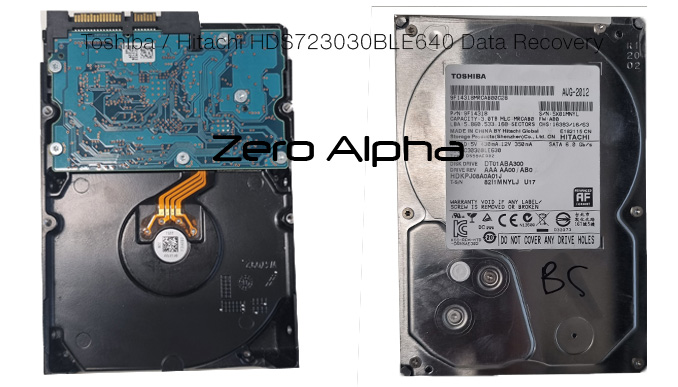Toshiba / Hitachi HDS5C3030BLE630 - MZ6OAAB0 Data Recovery
The Toshiba/Hitachi HDS5C3030BLE630 - MZ6OAAB0 is a hard drive model that offers high storage capacity and reliable performance. With a storage capacity of 3TB, it provides ample space for storing a vast amount of data, including documents, media files, and applications. This hard drive features a SATA interface, allowing for easy and efficient connectivity with compatible devices. It operates at a rotational speed of 7200 RPM (revolutions per minute), enabling fast data access and transfer rates. The Toshiba/Hitachi HDS5C3030BLE630 - MZ6OAAB0 is designed to deliver dependable performance and is suitable for various applications, including desktop computers, workstations, and servers. Its robust construction and advanced technologies ensure durability and efficient data management, making it a reliable choice for users with high-capacity storage needs.

What is an ABR error?
ABR (Address Boundary Recalculation) errors refer to issues that arise when the hard drive's firmware encounters difficulties in accurately determining the location of data stored on the drive. These errors can result in data loss, corruption, and inaccessibility, causing significant disruptions to individuals and businesses relying on the affected hard drive.
ABR errors on hard drives can occur due to various reasons, including:
-
Firmware Corruption: Firmware, responsible for controlling the operation of the hard drive, can become corrupted due to software bugs, power surges, or other factors, leading to ABR errors.
-
Mechanical Failures: Physical issues such as head crashes, motor failures, or read/write arm malfunctions can disrupt the accurate reading of data, resulting in ABR errors.
-
Platter Damage: Damage to the magnetic platters where data is stored can cause ABR errors as the read/write heads struggle to locate the correct address boundaries.
-
Aging and Wear: Over time, hard drives experience wear and tear, which can contribute to ABR errors, especially in older drives.
Preventive Measures to Minimize the Risk of ABR Errors on Hard Drives
To minimize the risk of ABR errors and data loss on hard drives, it is advisable to implement the following preventive measures:
-
Regular Backups: Maintain up-to-date backups of important data stored on hard drives to facilitate recovery in the event of ABR errors or other failures.
-
Power Surge Protection: Use surge protectors or uninterruptible power supplies (UPS) to safeguard hard drives from power fluctuations and electrical surges.
-
Avoid Physical Shocks: Handle hard drives with care and avoid subjecting them to physical shocks or impacts that could lead to ABR errors.
-
Temperature and Humidity Control: Ensure that hard drives are stored in a controlled environment, free from excessive heat, moisture, or humidity, as these factors can contribute to drive malfunctions.
Attempting DIY solutions or using inexperienced recovery methods can exacerbate the issue and potentially lead to permanent data loss. Professional data recovery experts possess the necessary tools, expertise, and cleanroom facilities to effectively recover data from hard drives affected by ABR errors.
Zero Alpha Data Recovery's Approach to Recovering Data from ABR Errors
Zero Alpha Data Recovery follows a systematic and meticulous approach to recover data from hard drives affected by ABR errors. Their process includes:
-
Firmware Repair: ABR errors often stem from firmware corruption or conflicts. Data recovery specialists can attempt to repair the firmware by using specialized tools and techniques. This involves analyzing the firmware modules, identifying corrupted or missing components, and replacing or repairing them to restore the drive's functionality.
-
Logic Board Replacement: In some cases, the ABR error may be caused by a malfunctioning logic board. Data recovery experts can replace the faulty logic board with a compatible one, allowing the drive to regain functionality and enabling data recovery.
-
Read/Write Head Replacement: ABR errors can also be related to issues with the read/write heads. These heads are responsible for reading and writing data on the hard drive platters. If the heads are damaged or misaligned, data access becomes problematic. Data recovery specialists may replace the faulty heads with compatible and functioning ones to recover data from the affected drive.
-
Data Extraction and Reconstruction: Once the physical issues are resolved, the next step is to extract the data from the drive. Data recovery experts use specialized hardware and software tools to extract the data sector by sector. In cases where the logical structure of the data is compromised, experts employ advanced techniques to reconstruct the file system and recover the data in a usable format.
-
Data Integrity Checks: After data extraction, data recovery professionals perform thorough checks to ensure the integrity and accuracy of the recovered data. They validate the recovered files, including documents, images, videos, and other data types, to ensure they are intact and functional. If any inconsistencies or errors are detected, additional measures are taken to recover the missing or corrupted data.